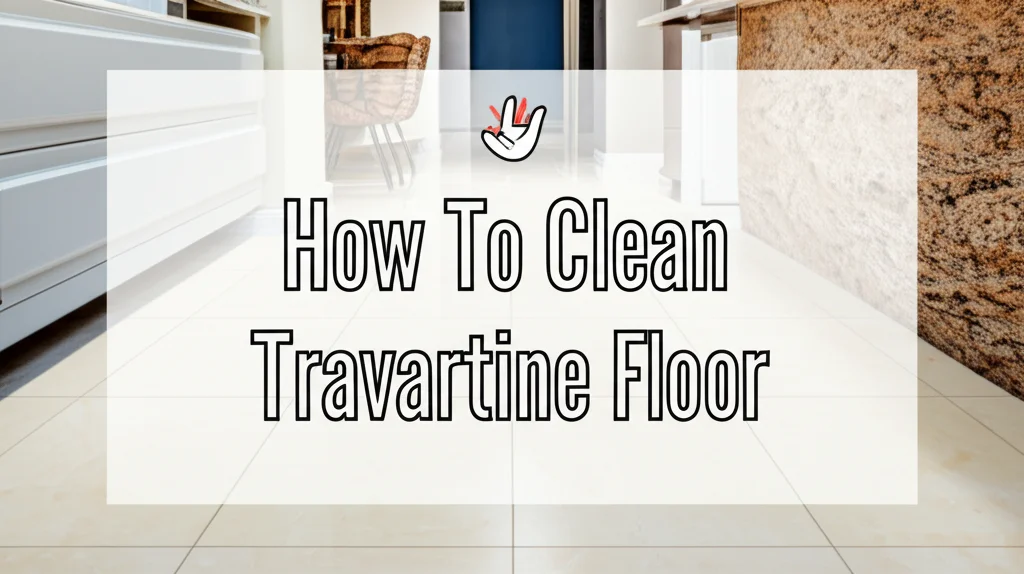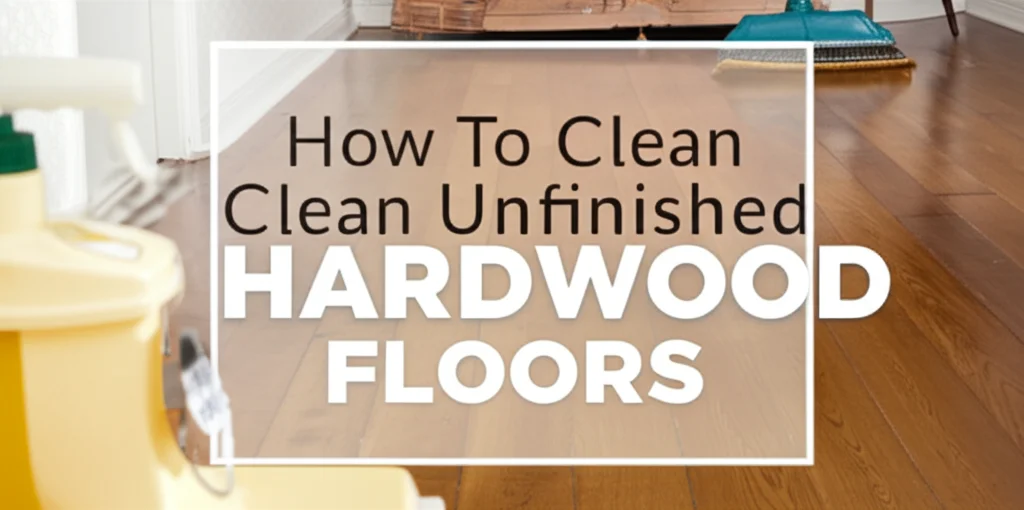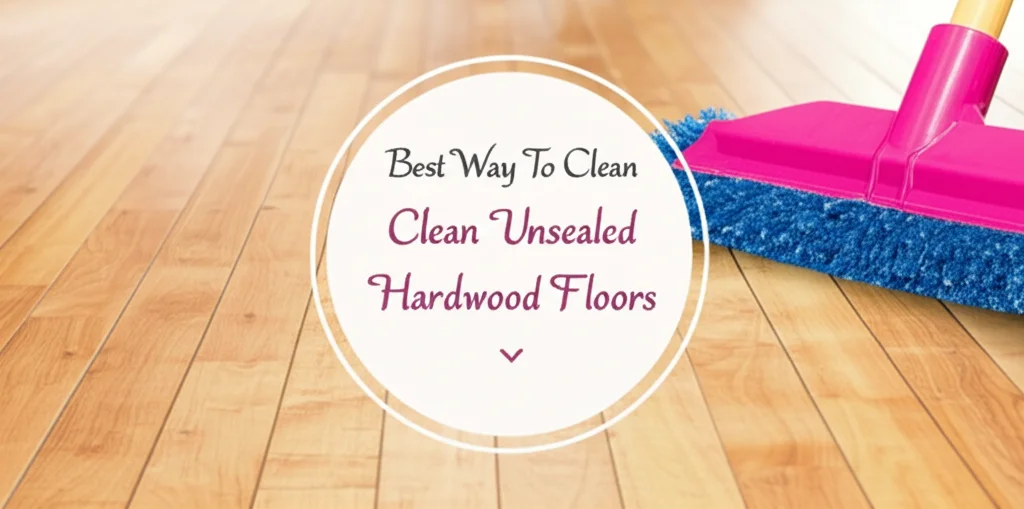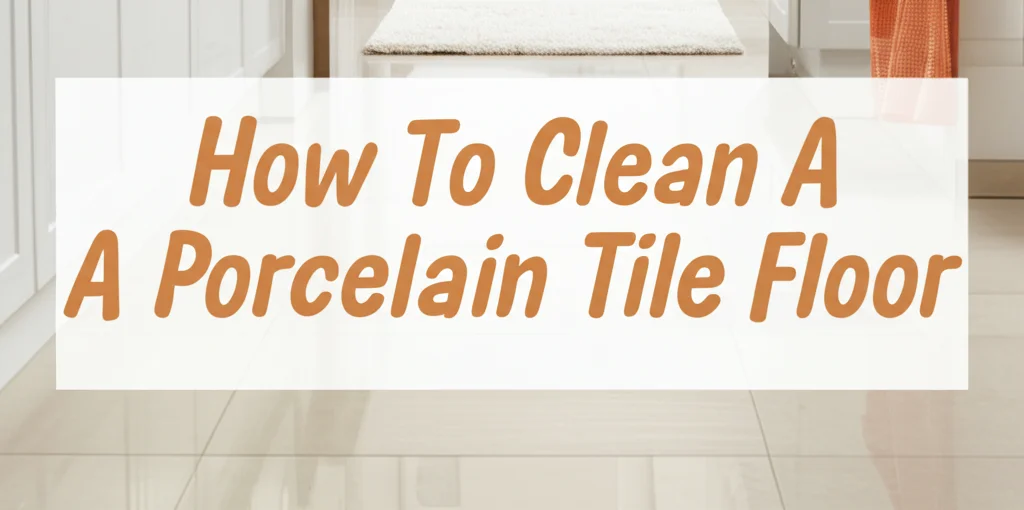· Flooring · 13 min read
How To Clean Travertine Floor

How to Clean Travertine Floors: The Ultimate Guide to Proper Maintenance
Travertine floors add a timeless, elegant appeal to any home with their natural beauty and unique patterns. However, these luxurious natural stone floors require specific cleaning methods to maintain their appearance and longevity.
Learning how to clean travertine floors properly will protect your investment and keep your floors looking stunning for years to come. This comprehensive guide covers everything from daily maintenance to deep cleaning and stain removal for both indoor and outdoor travertine surfaces.
Takeaway
- Use pH-neutral cleaners specifically designed for natural stone
- Never use vinegar, acidic, or abrasive cleaners on travertine
- Regular maintenance prevents permanent staining and damage
- Seal your travertine floors every 1-2 years for maximum protection
- Clean spills immediately to prevent etching and staining
Understanding Travertine: What Makes It Special and Vulnerable
Travertine is a type of limestone formed by mineral deposits from hot springs. This natural stone features distinctive pitted holes and troughs in its surface, giving it character but also making it susceptible to damage. Before diving into cleaning methods, it’s important to understand why travertine requires special care.
Travertine has a porous structure, making it vulnerable to staining and etching when exposed to acidic substances. Its calcium carbonate composition means that acidic cleaners like vinegar, lemon juice, or bathroom cleaners can literally dissolve the surface, causing permanent damage. Additionally, the filled or unfilled holes in travertine can trap dirt and debris, requiring regular maintenance.
The unique properties of travertine influence all cleaning approaches. Its natural beauty can be preserved for decades when treated properly, but improper cleaning can lead to costly damage. Understanding these characteristics will help you make informed decisions about travertine floor maintenance.
Travertine Finishes and How They Affect Cleaning
Travertine comes in several finishes, each requiring slightly different cleaning approaches:
- Polished travertine: Has a glossy, reflective surface that shows scratches more easily
- Honed travertine: Features a matte, satin-smooth finish that hides minor imperfections
- Tumbled travertine: Offers a textured, rustic appearance with more grip for outdoor areas
- Brushed travertine: Provides a softly textured surface with some weathered characteristics
Each finish affects how dirt adheres to the surface and how aggressively you can clean without causing damage. Generally, honed and tumbled travertine can handle slightly more vigorous cleaning than polished surfaces, which scratch more easily.
Essential Daily Cleaning Routine for Travertine Floors
The secret to maintaining beautiful travertine floors is consistent, gentle cleaning. Daily maintenance prevents dirt buildup that can scratch the surface and removes substances before they can stain or etch the stone.
Start by removing loose debris with a soft-bristled broom or dust mop. Avoid vacuum cleaners with beater bars that can scratch the surface. For daily mopping, use warm water with a few drops of pH-neutral stone cleaner in a well-wrung microfiber mop. Never saturate travertine with water as excess moisture can penetrate the stone.
For optimal results:
- Sweep or dust mop the entire floor to remove loose particles
- Mix a few drops of pH-neutral stone cleaner with warm water
- Wring out the mop thoroughly so it’s barely damp
- Clean in sections, rinsing and wringing the mop frequently
- Change the water when it becomes visibly dirty
- Allow the floor to air dry completely
This simple routine is the foundation of travertine maintenance. Regular cleaning prevents the need for more aggressive methods that might damage the stone over time.
How to Clean Travertine Floors Naturally: Safe Alternatives
If you prefer natural cleaning methods, you can safely clean travertine without harsh chemicals. However, it’s crucial to avoid acidic natural cleaners like vinegar or lemon juice that will damage the stone.
Safe natural options for travertine include:
- Warm water alone for light cleaning
- Mild castile soap (ensure it’s pH-neutral) highly diluted in water
- Baking soda paste (for spot treatments only, not regular cleaning)
- Commercial stone cleaners labeled as “natural” and “pH-neutral”
One effective natural approach is to use a microfiber cloth dampened with plain warm water for daily wipe-downs, followed by drying with a clean towel. For slightly deeper cleaning, a solution of warm water with a small amount of mild castile soap can be effective.
Remember that “natural” doesn’t always mean “safe for natural stone.” The pH level is more important than whether an ingredient is synthetic or natural. Always test natural cleaning solutions in an inconspicuous area first.
Deep Cleaning Methods for Travertine Tile Floors
Even with diligent daily care, travertine floors occasionally need deeper cleaning to remove accumulated dirt and restore their natural beauty. Deep cleaning should be done every 3-6 months depending on foot traffic.
For a thorough deep clean:
- Clear the area of furniture and obstacles
- Sweep and dust thoroughly to remove surface debris
- Mix a specialized stone cleaner according to manufacturer instructions
- Work in small sections using a soft mop or cloth
- For stubborn dirt in textured areas, use a soft-bristled brush
- Rinse thoroughly with clean water to remove residue
- Dry completely with clean towels or a dry microfiber mop
For heavily soiled floors, you might consider using a travertine floor cleaner machine designed specifically for natural stone. These machines provide gentle but effective cleaning without risking damage to the stone surface.
Is Steam Cleaning Safe for Travertine Floors?
Steam cleaning travertine floors is a controversial topic among stone care professionals. While steam can provide deep cleaning without chemicals, the high heat and moisture can potentially damage travertine and its sealant over time.
If you choose to steam clean travertine:
- Use only on well-sealed floors
- Keep the steamer moving continuously
- Use the lowest effective steam setting
- Ensure the floor dries completely afterward
- Don’t steam clean more than once or twice a year
Many stone experts recommend avoiding steam cleaning altogether in favor of appropriate stone cleaners. However, if you’re dealing with particularly stubborn dirt, a commercial steam cleaner on a low setting might be used occasionally, followed by resealing the floor. Be aware that this may void some floor warranties, so check manufacturer recommendations first. For safer alternatives, consider reading about proper cleaning methods for other types of flooring.
Removing Stains from Travertine Floors
Accidents happen, and knowing how to address stains quickly can prevent permanent damage to your travertine floors. Different types of stains require different treatment approaches:
Oil-Based Stains (cooking oil, grease, cosmetics)
- Blot up excess oil immediately (don’t wipe as it spreads the stain)
- Create a paste of baking soda and water
- Apply to the stain and cover with plastic wrap
- Allow to sit for 24-48 hours to draw out the oil
- Rinse thoroughly and dry
Organic Stains (coffee, tea, wine, food)
- Blot up the spill immediately
- Mix hydrogen peroxide with a few drops of ammonia
- Apply to the stain with a clean cloth
- Cover with plastic wrap for several hours
- Rinse thoroughly and dry
Water Stains and Mineral Deposits
- Use a specialized stone poultice powder mixed with distilled water
- Apply a thick layer to the stain
- Cover with plastic wrap and tape down the edges
- Allow to dry completely (24-48 hours)
- Remove the dried poultice and rinse the area
For particularly stubborn stains, commercial stone stain removers formulated for travertine may be necessary. Always test any stain removal product in an inconspicuous area first. If you’re dealing with severe staining that these methods don’t resolve, professional stone restoration services might be required. Learn more about dealing with stubborn stains on other surfaces.
Cleaning and Maintaining Outdoor Travertine Tile
Outdoor travertine requires additional considerations due to exposure to weather, organic matter, and potentially harsher conditions. Regular maintenance prevents degradation from environmental factors.
For outdoor travertine cleaning:
- Remove debris frequently with a soft broom or leaf blower
- Rinse with a garden hose to remove dirt (avoid high-pressure washers)
- Use a pH-neutral stone cleaner diluted in water for regular cleaning
- Address algae or mold with a specialized stone-safe cleaner
- Reseal outdoor travertine more frequently (every 6-12 months)
Outdoor travertine is especially vulnerable to organic staining from leaves, berries, and other plant materials. Prompt removal of these items prevents them from leaching colors into the stone. In winter, avoid using salt-based ice melters which can damage travertine; instead, use sand for traction or calcium magnesium acetate (CMA) ice melters that are safe for natural stone. Understanding proper cleaning techniques for outdoor spaces can also be helpful.
Cleaning Travertine Tile Shower and Bathroom Surfaces
Bathroom travertine presents unique challenges due to constant exposure to water, soap, and potential mold issues. Regular cleaning prevents soap scum buildup and water spots that can be difficult to remove once established.
For travertine showers and bathrooms:
- Squeegee shower walls after each use to remove excess water
- Use a daily shower spray formulated for natural stone
- Clean weekly with a pH-neutral stone cleaner
- Address grout lines with a soft brush and appropriate cleaner
- Check for and repair any grout damage promptly
Preventing mold and mildew is crucial in shower environments. Adequate ventilation and keeping the stone dry helps prevent these issues. For existing mold problems, use a stone-safe mold remover rather than bleach or other harsh chemicals that can damage travertine. For detailed guidance on cleaning shower surfaces, consider reading about removing mold from shower caulking.
Restoring Shine to Travertine Floors
Over time, travertine floors may lose their luster due to wear and improper cleaning. Restoring the shine depends on the finish type and extent of dulling.
For polished travertine:
- Clean thoroughly with a pH-neutral cleaner
- Apply a stone polish formulated for travertine
- Buff with a soft, dry microfiber cloth
- Consider professional honing and polishing for severely dulled floors
For honed or tumbled travertine:
- Clean thoroughly with appropriate stone cleaner
- Apply a stone enhancer to bring out natural colors
- Ensure proper sealing to maintain appearance
Using floor protectors under furniture and placing rugs in high-traffic areas can help maintain the shine longer. Regular maintenance and proper cleaning prevent the need for more intensive restoration. However, if your floors are severely damaged or worn, professional refinishing may be necessary.
Travertine Floor Protection: Sealing and Preventative Measures
Prevention is always easier than remediation when it comes to travertine floors. Proper sealing and preventative care extend the life and beauty of your investment.
Sealing Travertine Properly
- Clean the floor thoroughly and allow to dry completely (24-48 hours)
- Choose a high-quality impregnating sealer designed for travertine
- Apply sealer according to manufacturer instructions using a paint pad
- Allow the recommended dwell time (usually 5-10 minutes)
- Remove excess sealer with clean, dry cloths
- Apply a second coat if recommended
- Allow 24-48 hours before resuming normal use
Most travertine floors benefit from resealing every 1-2 years, though high-traffic areas may need more frequent application. To test if your floor needs resealing, place a few drops of water on the surface - if the water beads up, the seal is intact; if it soaks in, it’s time to reseal.
Daily Preventative Measures
- Use doormats at all entrances to reduce dirt and grit
- Place felt protectors under furniture legs
- Clean spills immediately to prevent staining
- Use coasters under glasses and drinks
- Avoid dragging heavy objects across the floor
- Keep pet nails trimmed to prevent scratches
These simple habits significantly extend the life of your travertine floors and maintain their beauty. Learning how to protect various types of flooring can help you develop good maintenance habits.
Cleaning Travertine Tables and Other Surfaces
Travertine isn’t just for floors - it’s also used for tables, countertops, and decorative elements. These surfaces require similar care but may need more frequent attention.
For travertine tables and countertops:
- Use coasters under glasses and placemats under dishes
- Wipe spills immediately with a soft cloth
- Clean daily with a stone-safe cleaner and microfiber cloth
- Avoid placing hot items directly on the surface
- Apply a stone-specific polish periodically to maintain luster
Travertine tables in particular are vulnerable to ring marks from glasses and etching from acidic foods. Prompt cleaning and protective measures prevent these issues. For outdoor travertine tables, cover when not in use to protect from weather elements and tree sap.
Travertine Floor Cleaning Tools and Products
Using the right tools and products makes travertine cleaning more effective and prevents damage. Here’s what you need in your travertine cleaning arsenal:
Essential Tools
- Soft-bristled broom or dust mop
- Microfiber mops and cloths
- Soft sponges for spot cleaning
- Plastic scraper for solid material removal
- Soft-bristled brushes for grout lines
- Absorbent cloths for drying
Recommended Products
- pH-neutral stone cleaner
- Stone soap for regular maintenance
- Impregnating stone sealer
- Stone polish for polished finishes
- Stone enhancer for honed/tumbled finishes
- Stone-safe poultice for stain removal
Avoid tools with abrasive surfaces and highly alkaline or acidic products. Never use general-purpose cleaners, vinegar, lemon, ammonia, or bleach on travertine surfaces. For more information on selecting cleaning products for different surfaces, read about choosing the best cleaning solution for ceramic tile floors.
Common Travertine Cleaning Mistakes to Avoid
Many travertine maintenance problems stem from common mistakes that are easily avoided once you’re aware of them:
- Using acidic cleaners - Vinegar, lemon juice, and many bathroom cleaners will etch travertine
- Employing abrasive tools - Steel wool, stiff brushes, and abrasive pads scratch the surface
- Allowing standing water - Water left on travertine can penetrate and cause staining
- Using generic floor cleaners - Many contain ingredients harmful to natural stone
- Neglecting to seal properly - Unsealed travertine is highly vulnerable to staining
- Over-wetting when cleaning - Excessive moisture can penetrate the stone and cause damage
- Dragging furniture - Always lift furniture to prevent scratches and chips
- Ignoring spills - Even water can eventually stain or damage travertine if left standing
Avoiding these mistakes dramatically extends the life and appearance of your travertine floors. When considering how different floor types require different approaches, you might also want to learn about cleaning luxury vinyl plank flooring.
Frequently Asked Questions About Travertine Floor Care
What is best to clean travertine floors?
The best cleaning solution for travertine floors is a pH-neutral cleaner specifically formulated for natural stone. These cleaners effectively remove dirt without damaging the stone’s surface. For daily cleaning, warm water with a few drops of stone cleaner on a well-wrung microfiber mop is ideal. Commercial products like Black Diamond Stone Floor Cleaner or Granite Gold Stone Floor Cleaner are excellent options.
How do I get my travertine floor to shine again?
To restore shine to travertine floors, first clean thoroughly with a pH-neutral stone cleaner. For polished travertine, apply a stone polish designed specifically for natural stone using a soft cloth and buff to a shine. Severely dulled floors may require professional honing and polishing. Ensure the floor is properly sealed to maintain the shine.
What should you not use on travertine?
Never use acidic cleaners (vinegar, lemon juice, bathroom cleaners), abrasive tools (steel wool, stiff brushes), bleach, ammonia, or general-purpose cleaners on travertine. Avoid steam cleaning on unsealed travertine and high-pressure water systems that can damage the surface. Don’t use wax-based products that can build up and dull the finish.
Is vinegar good for travertine floors?
No, vinegar should never be used on travertine floors. Vinegar is acidic with a pH of approximately 2-3, which will etch and damage travertine’s calcium carbonate composition. Even diluted vinegar causes microscopic damage that accumulates over time, leading to dulling and deterioration of the stone surface. Always use pH-neutral cleaners specifically designed for natural stone.
Final Thoughts on Travertine Floor Maintenance
Maintaining travertine floors requires specific care, but the effort is worthwhile to preserve their natural beauty and longevity. Regular cleaning with the right products, prompt attention to spills, and proper sealing create a maintenance routine that protects your investment for decades.
The key to successful travertine care is understanding its unique properties and vulnerabilities. By using pH-neutral cleaners, avoiding acidic substances, and implementing preventative measures, you can enjoy your travertine floors’ elegant appearance with minimal long-term maintenance issues.
Remember that different travertine finishes may require slightly different approaches, and outdoor applications face different challenges than indoor floors. When in doubt, consult with a stone care professional about specific concerns or persistent problems.
With proper care, your travertine floors will continue to be a stunning feature of your home for generations to come.




